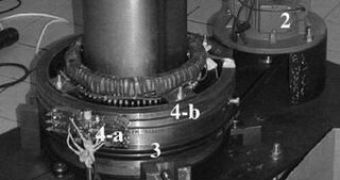The design of the electric motor, which converts electrical energy into mechanical energy, hasn't changed much since it was invented, some 50 years ago. New technological developments in the field of superconductors are about to change that.
El Hadj Ailam and colleagues working at the Universit? Henri Poincar? in Nancy, France and the Center for Advanced Power Systems in Tallahassee, Florida, have been working on a new electric motor design, which will be more compact, more energy efficient and less expensive.
This superconducting rotating machine will hopefully make present applications, like washing machines, toys and fans, smaller and more effective, by replacing conventional copper coils with superconducting wires.
"This work has two goals," said Ailam, who is currently with the Centre Universitaire Khemis Miliana in Algeria. "The first is to show the feasibility of an electrical motor based on the magnetic flux density, and the second is to demonstrate that superconductors can significantly ameliorate the electrical machine performances."
The new design is a high-temperature motor, an eight-pole machine with a stationary superconducting inductor, made of niobium-titanium (NbTi), which has no electrical resistance, one of the greatest advantages of superconductors.
"For the majority of electrical superconducting machines, the structure is a classical one, and the magnetic flux is a radial one," Ailam explained. "[However] for our machine, the inductor magnetic flux is an axial one."
This allowed them to produce a performance of 118.8 volts for the motor, but they hope to further improve it, in order to make it achieve the highest output theoretically proven so far, of 172.5 volts.
"As we demonstrate in another paper, under realization, using this structure with several superconducting wires and 20 mW generated power decreases the inductor volume 20-50 percent in comparison to a classical electrical machine," Ailam said.
"The major advantages of these motors are a high power-volume density and a high torque-volume density, and less vibration than for the conventional motors," Ailam said. "I think that the maritime propulsion can and the electrical traction generally can benefit principally to these motors."
The team's biggest project for the near future will be to design and build a 100 kW superconducting machine using the same configuration.

 14 DAY TRIAL //
14 DAY TRIAL //